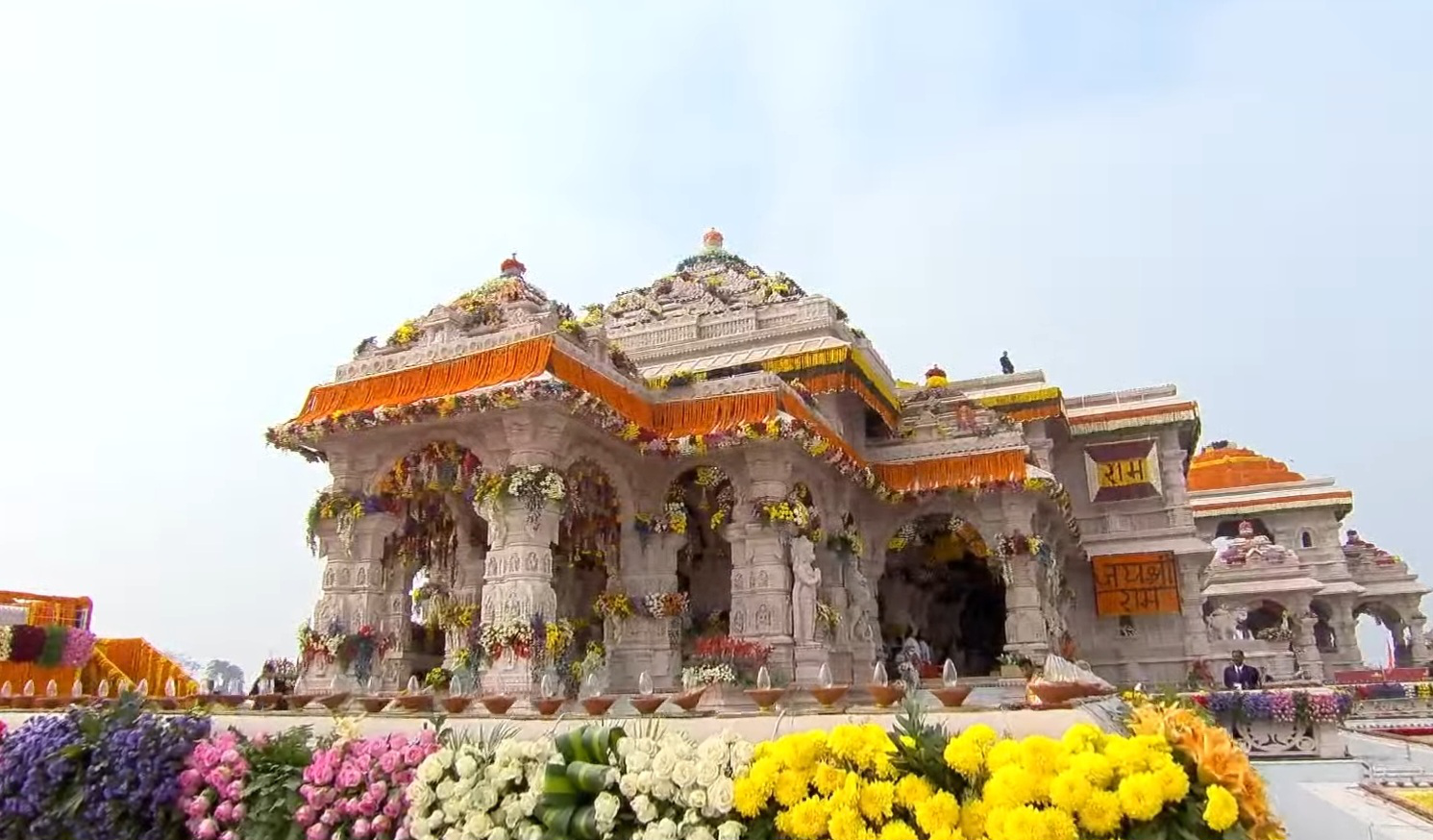In the heart of Ayodhya, Uttar Pradesh, the magnificent Ram Mandir Of Ayodhya stands tall,
- a monumental structure, echoing the enduring spirit of the Hindu community.
More than just an architectural marvel, this grand temple represents a journey steeped in historical significance, cultural heritage, and unwavering devotion to Lord Ram.
As we embark on a historical exploration, witnessing decades-long efforts culminate in the Ram Mandir,
- it emerges as an iconic symbol of faith, unity, and the triumphant spirit of truth and righteousness.

Who Is Ram Lalla Of Ram Mandir in Ayodhya?
Ram Lalla, also known as Ramlalla or Infant Lord Rama, holds a revered position as a deity in Hinduism,
- embodying the divine essence of Lord Rama in his childhood form.
The term “Ram Lalla” literally translates to “Rama, the child,” encapsulating the spiritual significance attached to this manifestation.
Within Hindu religious and cultural traditions, the narrative of Ram Lalla intricately weaves into the tapestry of the epic Ramayana.
Delving into the pages of the Ramayana, an ancient Indian epic attributed to the sage Valmiki,
- we encounter the profound story of Lord Rama, revered as the seventh avatar of Lord Vishnu.
He showcases that a warrior’s strength lies not only in physical might but also in moral rectitude, making him one of the greatest warriors.
The epic intricately chronicles Lord Rama’s life and adventures,
- with one of its pivotal events revolving around the heroic rescue of Lord Rama’s wife, Sita, from the clutches of the demon king Ravana.
The connection between Lord Rama and the sacred city of Ayodhya plays a central role in understanding the significance of Ram Lalla.
Ayodhya, believed to be Lord Rama’s birthplace, houses the revered Ram Janmabhoomi, adding a layer of sanctity to the narrative.
Quick Historical Backdrop Of Ram Mandir In Ayodhya
The historical backdrop is further enriched by the construction of the Babri Masjid in the 16th century by the Mughal emperor Babur,
- sparking religious and political tensions that persisted for centuries.
The Babri Masjid-Ram Janmabhoomi dispute emerged as a contentious issue, resulting in legal and social conflicts.
The climax came with the demolition of the Babri Masjid on December 6, 1992, orchestrated by a Hindu activist mob.
Post the demolition, the site became a focal point for legal battles and political discourse.
In a landmark verdict in 2019, the Supreme Court of India granted the disputed land to Hindus,
- paving the way for the construction of a grand temple dedicated to Lord Rama.

The Divine Embodiment
Ram Lalla, the divine embodiment, found a temporary abode in a ceremonious structure at the site,
- patiently awaiting the commencement of the construction of the Ram Mandir in Ayodhya.
This monumental endeavour holds profound significance for the Hindu community,
- symbolizing the fulfilment of a longstanding aspiration to establish a grand temple at the revered birthplace of Lord Rama.

The Journey So Far Of Ram Mandir In Ayodhya
I. Historical Context: The Epic Saga of Ayodhya
The roots of the Ram Mandir in Ayodhya delve deep into the pages of the Ramayana, an ancient Indian epic credited to the sage Valmiki.
Lord Rama, the seventh avatar of Lord Vishnu, graced the city of Ayodhya with his divine presence,
- marking the land as the Ram Janmabhoomi – Lord Rama’s birthplace.
However, this sacred site endured centuries of turmoil,
- including the construction of the Babri Masjid by Mughal emperor Babur in the 16th century.
II. The Babri Masjid-Ram Janmabhoomi Dispute: A Long Struggle for Justice
The disputed site became a flashpoint for religious and political tensions, sparking a legal and social conflict that spanned decades.
The pivotal moment arrived on December 6, 1992, when a Hindu activist mob demolished the Babri Masjid,
- escalating tensions between communities.
Legal battles and political deliberations ensued, shaping the destiny of this sacred land.
III. Supreme Court Verdict: Paving the Way for the Ram Temple
In a historic judgment in November 2019, the Supreme Court of India unanimously granted the disputed land to Hindus for the construction of the Ram Mandir in Ayodhya.
The court also directed the government to allocate an alternative piece of land for the construction of a mosque.
This landmark decision provided a legal foundation for the realization of the long-standing aspiration to rebuild the Ram Temple.
IV. The Birth of Shri Ram Janmabhoomi Teerth Kshetra: Overseeing the Construction
Following the Supreme Court verdict, the Indian government established the Shri Ram Janmabhoomi Teerth Kshetra in February 2020.
This trust, entrusted with overseeing the construction, became the custodian of the project,
- managing funds and ensuring the completion of the temple.
The formation of the trust marked a significant step toward the realization of the dream cherished by millions.
V. Bhoomi Pujan: A Divine Groundbreaking Ceremony
On August 5, 2020, the Bhoomi Pujan, or groundbreaking ceremony, unfolded with Prime Minister Narendra Modi participating in the auspicious event.
The ceremony marked the formal beginning of the temple’s construction, infusing the project with divine blessings and cultural significance.

VI. Architectural Splendor: The Grandeur of Nagara Style
The design of the Ram Temple was entrusted to the Sompura family of Gujarat,
- renowned for their expertise in temple architecture.
The temple, built in the Nagara style, boasts towering spires and intricate carvings reminiscent of ancient Hindu temples.
The pink sandstone used in construction adds to the visual splendour of this sacred edifice.
The temple is spread across an area of 2.77 acres.
It is surrounded by several smaller shrines in a large courtyard dedicated to other Hindu deities.
VII. Construction Progress: A Phased Journey to Grandeur
The construction of the Ram Temple progresses in phases,
- symbolizing meticulous craftsmanship and devotion invested in each aspect of the project.
The vision for the temple encompasses not only a grand structure in physical dimensions but also a spiritual and cultural resonance for millions.
VIII. Donations and Funding: A Collective Offering of Devotion
The construction of the Ram Temple has been made possible through voluntary donations from individuals and organizations.
Devotees from across India and around the world have contributed to the fundraising campaign,
- reflecting the collective devotion and commitment to this historic endeavour.
IX. Inauguration Day Of Ram Mandir in Ayodhya: A Momentous Occasion
On January 22, 2024, the Ram Mandir was inaugurated in a grand ceremony attended by
Narendra Modi, Prime Minister of India, served as the Mukhya Yajman (transl. chief patron) of rituals for the event.
The consecration ceremony, or pran pratishtha, conducted by Prime Minister Narendra Modi, was broadcast to millions,
- marking the culmination of a decades-long effort and a momentous occasion for the Hindu community.

The Eternal Ram Mandir In Ayodhya
In conclusion, the Ram Mandir in Ayodhya stands tall as a symbol of faith, unity, and cultural heritage.
Its journey from the pages of the Ramayana to the historic Supreme Court verdict and the subsequent groundbreaking ceremony is a testament to the resilience and determination of the Hindu community.
The architectural splendour, the phased construction, and the collective offerings of devotion encapsulate the spiritual and cultural significance of the temple.
Regimes and Seasons May Change, and Structures May Fall and Rise Again,
- but Our Faith in Lord Rama is Eternal.
rāmāya rāmabhadrāya rāmacaṃdrāya vedhase .
raghunāthāya nāthāya sītāyāḥ pataye namaḥ ..
As the Ram Mandir takes its place in the history of India, it signifies not just the triumph of truth and justice but also the beginning of a new era,
- a testament to the enduring spirit of the Hindu community and their unwavering devotion to Lord Rama.
Jai Shree Ram!









One response to “Ram Mandir in Ayodhya: Unveiling the Majestic Triumph of Faith”
[…] Ram‘s forehead every Rama Navami, referred to as Surya Tilak, a mechanism installed at the Ram Mandir in […]